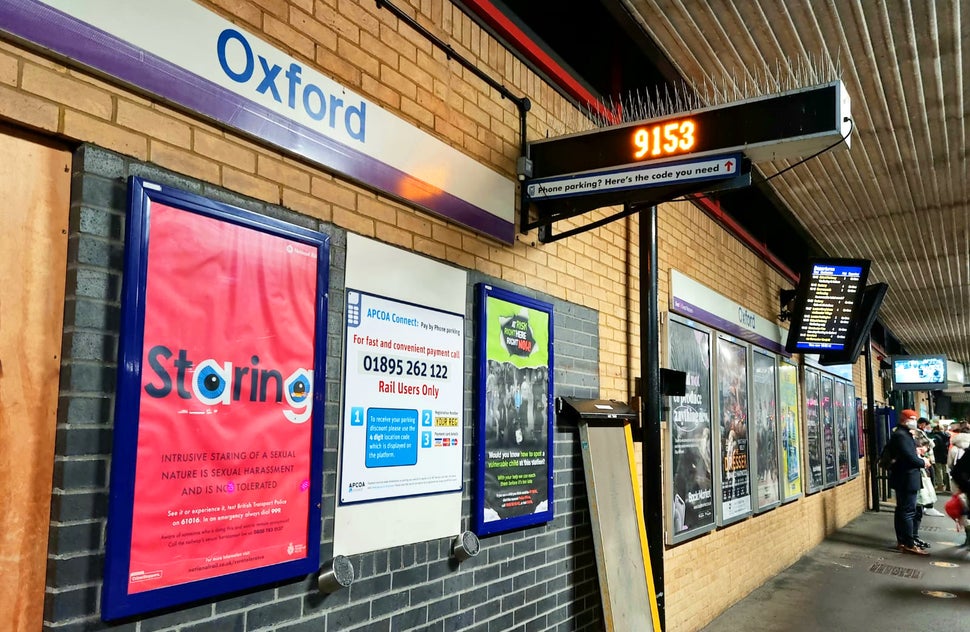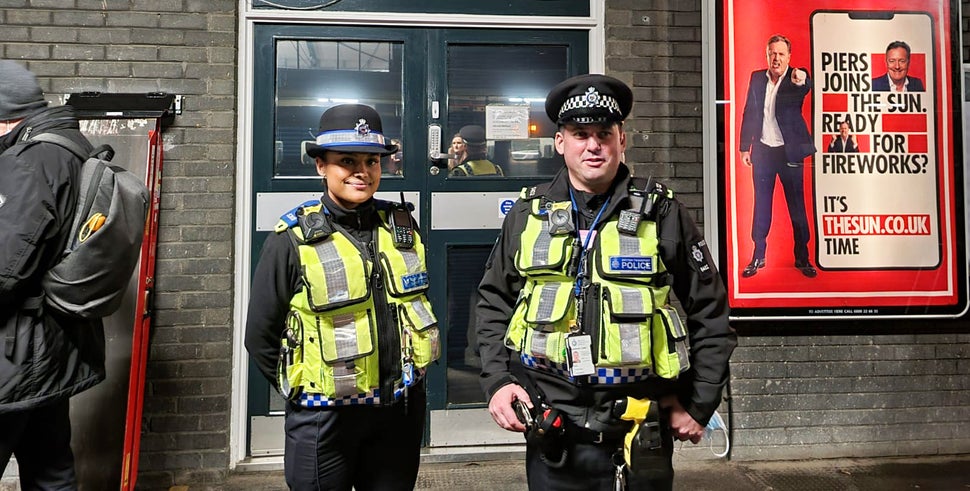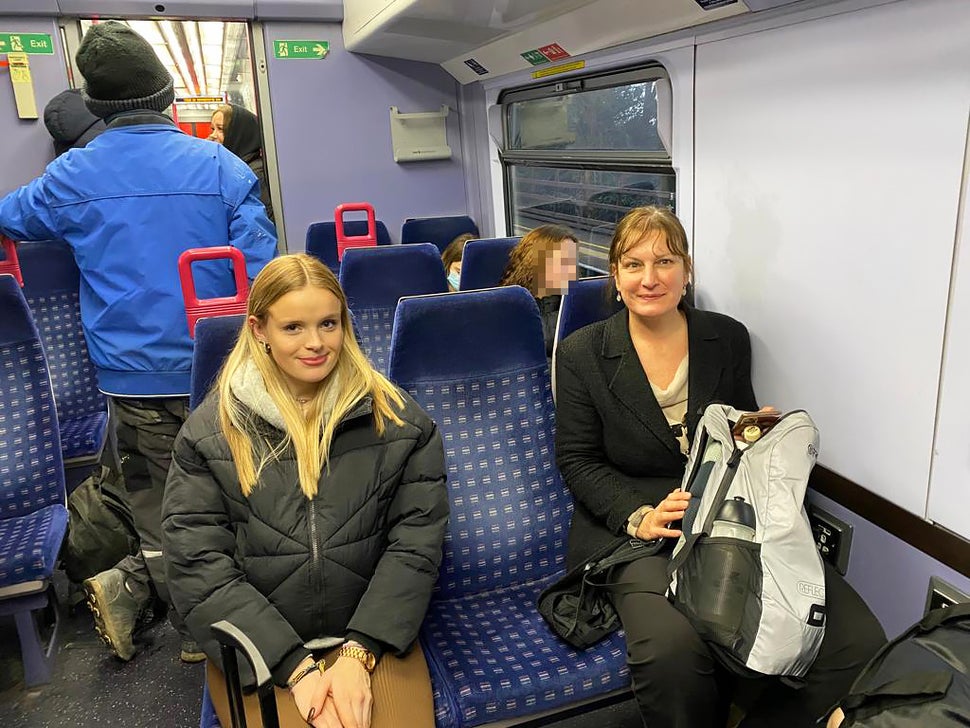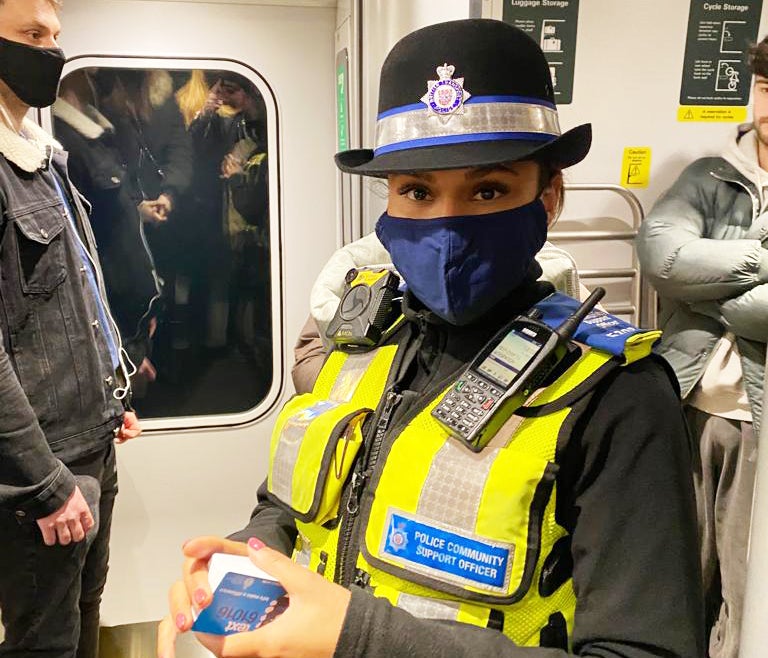
The word “staring” blinks from a red poster mounted on the wall at Oxford station. It’s part of a new campaign by the British Transport Police, aimed at highlighting inappropriate behaviour and improving the safety of women and girls on public transport. The majority of Friday evening commuters rush past it without a second glance, striding purposefully towards their trains to begin their weekends in earnest.
I’d usually be joining them. Today, though, the poster has caught my attention, because I’m shadowing two police officers on the beat between Oxford and Reading, as they show me this new initiative in action.
British Transport Police (BTP) has committed to displaying an increased police presence on trains and at stations as part of a dedicated operation focused on women’s safety. They’ve also invested in posters around stations nationwide, and printed leaflets, telling passengers how to report sexual harassment.
I meet police constable Clive Jackman at the BTP office inside Oxford station as he starts his eight-hour shift. He’s getting kitted up, ready for a patrol, while his sergeant, Rebecca McDonald, works at her computer.
PC Jackman works on a rota, so there’s no typical day, but his job involves helping ticket officers manage fare disputes, speaking to station staff about anything “unusual”, dealing with reports of stolen bikes, intervening with any drunken passengers, and interacting with the local homeless community in and around the station.
He also deals with any other incidences on his patch that have been reported to the police via the 61016 text service. The women’s safety initiative is largely focused on encouraging the public to use this number.

Surprisingly, PC Jackman tells me he’s never directly intervened with a report relating to harassment or abuse of women. When these texts come through, the race is on to find the nearest unit to respond and the message is often sent “up the line”.
It’s why the force is encouraging victims to report any incidents as they’re happening – with clear details of their train time and destination – so that it’s easier to catch up with victims. “It’s like you’re chasing trains,” PC Jackman explains. “By the time we know about it here at Oxford, the chances are, they’ve got off long before they’ve talked to us.”
That’s not to say reports don’t come in. Reports of sexual harassment and sexual offences on the railways have risen by 63% compared to pre-pandemic figures from 2019. This includes anything from exposures and groping, to pressing, upskirting, sexual comments and leering.
Reports of cyberflasing – the sending of unsolicited dick pics via apps such as AirDrop – remain low. This is despite the fact that HuffPost UK has interviewed over 70 women about their experiences, many of which happened on trains and other forms of public transport.

It’s hard to say what’s behind the jump in other incidents. The pandemic has led to quieter trains and this in itself can place women in more vulnerable, isolated environments. But high profile murders – including the deaths of Sarah Everard, Sabina Nessa and Ashling Murphy – have heightened public awareness of women’s safety. The high numbers could reflect an increase in women coming forwards, rather than an increase in offences.
Have officers had any specific training to deal with it? PC Jackman gives his sergeant a quick, uncertain look and she jumps in to reply to my question, explaining that there’s been “force briefings” sent down “from the powers that be in headquarters”. What exactly does that mean?
“It kind of gives us an outline of what we need to be briefing out to people and basically how to encourage people to report stuff to us,” she says.
We board the 16.36 train from Oxford to Didcot Parkway, which is largely full of students making their way home after college. PC Jackman walks down the train, saying “hello, how’s it going?” to various passengers – many of whom look surprised to see him.
Two 16-year-olds ask me why there’s a policeman on the train. I explain it’s part of an initiative to make young women feel safer, and one of the girls proceeds to tell me about the time a man started “doing laps” around her at the station.
The man boarded her train and stared at her throughout the journey. When she reached her station, she got off and looked behind her. The man had moved towards the window of the train to watch her, and waved when they clocked eyes.
“I couldn’t stop thinking about it for the next two weeks and I was really uneasy when I was getting back on the train,” she says. “I haven’t been back to that station at that time since.”
As I walk through the carriages, I ask some other passengers if they feel safe on public transport and at stations. “In comparison to South Africa, this is really lovely!” say Leonie Ellis, a 51-year-old who moved to the UK from South Africa several years ago. “There’s cameras and lights on every platform.”
Lizzie Partridge, an 18-year-old sitting two seats away, disagrees. “In the daytime I feel fine, but at nighttime if I’ve been out I don’t feel safe at all,” she says.
Recently, she was followed by a man after a night out. He kept trying to talk to her group of friends at Oxford station, then followed them on to the train. “There were some other girls on the train that we didn’t know, but we sat with them. And then he went to another carriage and another group of girls came and sat with us. So essentially, three groups of girls who didn’t know each other were sat together because of this one guy,” she says.
Partridge and her friends got off at Banbury station and the man followed them towards the exit. “We told the security guard but he was a little old man – he wasn’t going to do much!” she says. “There was just nobody about. I was nervous to go out in Oxford again and I wouldn’t get the train back now.”

It’s sad to hear that these young women are changing their behaviour because, by 16 and 18, they’ve already been made to feel unsafe on public transport.
Another woman, 32-year-old Gail Cowcher, tells me she’s never had any serious problems, “just general heckling”, and a man sitting next to her on an otherwise empty train. As women, we’ve been conditioned to minimise these moments when really, there’s no “just” about it.
I’m interested to learn more about what happens when women report incidents, because, realistically, “staring” is not illegal, nor is “trying to make conversation” with another passenger or choosing an empty seat. When these reports come in, PC Jackman says he looks at who’s said what, how they’ve said it, and why.
“There’s a little bit of [asking], is it just banter, is it just off the cuff comments, or is it something that’s meant more formally, is it someone who’s actually deliberately targeting someone for a specific reason,” he says. “Is it actually this [sexual harassment]? Or is it something that can be construed as that? It’s a bit of a grey area.”
Perhaps seeing my raised eyebrows at the mention of “banter”, the press officer (who’s been with us the entire journey) swiftly prompts PC Jackman, saying that “if someone feels uncomfortable, it’s not acceptable”.
“No and I understand that,” PC Jackman adds, quickly. “If they feel they’re a victim then as far as I’m concerned, they’re a victim and it’ll be recorded as such.”
These reports are used to build up intelligence, he explains. No, a passenger won’t be arrested for staring at another passenger, but if multiple people report uncomfortable behaviour on the same route at the same time, the police know where and when to concentrate resources, such as plain clothes officers. They look for patterns in the hope of catching perpetrators in the act. Reports also enable them to direct victims towards support services.

As the sun sets we board a quiet train at Didcot Parkway and travel to Reading, where we meet PC Jackman’s colleague, police community support officer Shahira Ali.
PSCO Ali tells me she’s passionate about tackling sexual harassment, because she receives a lot of unwanted comments herself. More than once, she’s been asked for her number while at work, with men becoming “pushy” when she’s said no.
“That’s the type of behaviour that I really don’t want to normalise,” she says. “I don’t want women to feel uncomfortable or to think that they just have to go to a different carriage and be done with it.”
The shift that sticks in her mind, she tells me, was the time she helped a woman in the station car park, who’d been punched in the jaw by her boyfriend. She also recalls the time she urged a female ticket inspector to report sexual harassment, after hearing a passenger had made “awful, lewd comments about her body”.
Today is a much quieter evening, however, and as we board a packed train heading back towards Oxford, the “patrol” largely consists of handing out the new sexual harassment leaflets to passengers.

The pink and purple leaflet, with an image of a woman on its cover, explains how to report sexual harassment and what happens next. It’s undoubtably useful, even if the onus to act is very much placed on victims – who are mostly women – to report crime, rather than on perpetrators to stop committing it.
It feels a step backwards when compared to Police Scotland’s Don’t Be That Guy campaign, which received widespread praise for tackling violence against women and girls by addressing male attitudes and behaviour.
Wouldn’t it have more impact if the police printed a second leaflet, and handed it out to men reminding them of the behaviour that won’t be tolerated?

The following Monday, I put this question to detective chief inspector Sarah White. She’s the British Transport Police’s women’s safety lead, in charge of writing the strategies and action plans for violence against women and girls, sexual offences and domestic abuse.
“I don’t think our campaigns are focused at women,” she says via video call. “I think our campaigns are trying to educate people as to what is appropriate and what’s inappropriate.”
On the topic of inappropriateness, I mention the use of the word “banter”by a male officer on Friday. While it may have been an off-the-cuff remark, it felt alarming in the context of an initiative that aims to tackle sexual harassment.
Language matters and getting it right is crucial to restoring public trust, particularly after Sarah Everard’s death at the hands of a police officer, and the recent investigation by the police watchdog that has uncovered evidence of misogyny, discrimination, bullying and sexual harassment within the Met.
“Firstly, I’m disappointed to hear that because we are working tirelessly to speak to officers and educate them about the use of terminology,” says DCI White. “There is no place for ‘banter’. Simple as that.”
She tells me about the efforts being made to ensure all officers are on board with the messaging surrounding the campaign.
For the past two months, she’s personally conducted live video calls with officers, explicitly detailing the expectations surrounding this topic and the campaign. Further training to “embed these behaviours” begins in April, and every officer up to and including the rank of inspector will be required to take part nationwide.
The training, she says, highlights what vulnerability looks like, what’s classed as inappropriate behaviour, and how officers should respond to reports of sexual harassment.
“The training is is not just around criminal investigations – because that’s equally important – but it’s also around [...] that really crucial part about intolerance, and it just not being acceptable,” she says.
Later this year, the force will also be rolling out audio clips that will be sent straight to officer’s phones while they’re responding to a report of sexual harassment. These clips will remind them how a victim may be feeling and how best to respond.
“I can’t put my hand on my heart and say every officer is currently at that level,” says DCI White. “But, that’s absolutely my goal and I’m confident we will achieve it.”
During Friday’s patrol, Lizzie Partridge – the 18-year-old who shared her experience – said she wished people would stop “turning a blind eye” to the issue. Other passengers had witnessed her group of friends being intimidated, she said, and did nothing.
DCI White says the force is encouraging bystander action when it’s safe to do so. BTP has created TikTok videos on this topic with advice. For example, asking someone “do you know the next stop?” can be a subtle way to show your presence and help diffuse a situation.
The moves do sound positive, but there’s much more to be done. Other women on Friday evening said they would like to see more staff on trains after dark, better lighting around stations, and more education aimed at men. I hope BTP can also take some of these ideas on board.
After my call with DCI White, it’s clear that some members of the police do seem to “get it”, but it’s not universal, and that is where the problem lies. We’ve heard the phrase “one bad apple” used far too many times recently in relation to the police.
As PCSO Ali put it: “Women should be able to leave their homes and feel safe. It really annoys me that we can’t.”